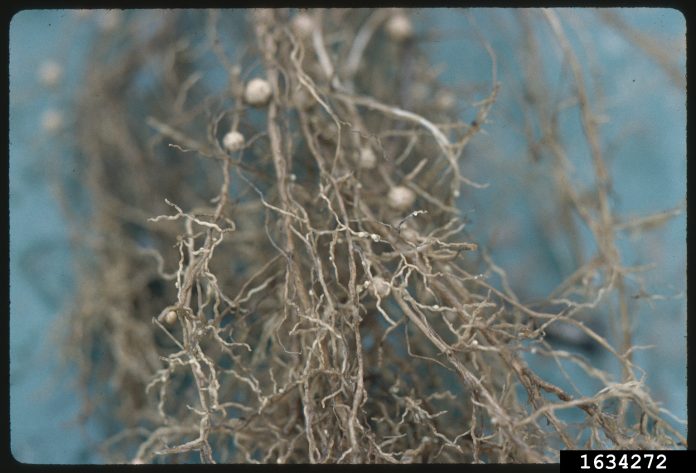HARRISBURG, Pa. — Get out your soil probes and shovels and help Penn State Extension, the SCN Coalition, and the Pennsylvania Soybean Board track the Soybean Cyst Nematode.
This tiny, silent, yet ferocious and fast-reproducing soybean pest often goes undetected before farmers see above-ground symptoms. SCN may be present in a soybean field and reduce soybean yield by 10% with no visible clues, which means it can go unnoticed for several years. When symptoms are visible, yield losses may already be as high as 50%.
The best way to diagnose and quantify SCN levels in the field is by sending soil samples to a professional diagnostic laboratory.
Free test
Free testing is being offered for Pa. soybean growers during the 2019 planting season. You can request a soil sample at your local Penn State Extension Office.
The soil bags contain sampling instructions, a label that needs to be filled out, and a field history form that must be returned along with the soil sample to your local Penn State Extension Agronomy Educator. There is a limited number of bags per county.
The deadline for sampling collection is June 20.
Yield robber
The Soybean Cyst Nematode is a plant parasitic nematodes (PPN), or microscopic roundworm that feed from living plant roots and other plant parts. Within the long list of soybean disease-causing agents in the United States, more yield is lost to Soybean Cyst Nematode (SCN) than any other nematode, bacterial or fungal pathogen.
In plants affected by SCN, water and nutrient uptake by the root will be impaired, the number of nodules formed on the roots will be reduced, and when above-ground symptoms are visible, plants will look yellow and stunted.
Lemon-shaped females are visible on the roots 5 to 6 weeks after planting.
Easy spread
Although SCN cannot move long distances by its own power, the adult nematode and the cysts (dead female bodies full of eggs) spread through anything that moves soil, like agricultural implements, tractor wheels, flood water, and strong winds.
SCN has already spread through 80% of all soybean growing areas in the country.
Reproduction rates
The nematode’s life cycle can be completed in 24 days, which means three to six generations of nematodes can occur during a growing season.
With each generation, more cysts containing eggs will be produced and can remain viable in the soil for up to 10 years.
In addition to soybeans, SCN hosts include cowpeas, sweet clover, hairy vetch, crimson clover, scarlet clover, alsike clover, birdsfoot trefoil, white lupine, yellow lupine, chickweed, wild mustard, and pokeweed.
Other diseases
Lesions in the roots caused by SCN feeding are infection courts for the pathogens that cause Sudden Death Syndrome, Brown Stem Rot, and Charcoal Rot. Severity of these diseases can increase in SCN-infested fields.
Broken resistance
One of the most important items in the toolbox for SCN management has been the use of resistant varieties, along with rotation to non-host crops. However, in recent years, SCN has adapted to the resistant varieties. The ability of SCN to reproduce on those varieties has dramatically increased.
Where is SCN in Pa.?
Soybean cyst nematode was found in Lancaster County in 2002; however, no further findings have been reported in subsequent surveys conducted by the Pa. Department of Agriculture.
Additionally, SCN infestations have been reported in eight counties along Pennsylvania borders, including three in Ohio, two in Maryland, one in Delaware, and two in New Jersey. The first report of SCN in New York occurred in 2017.
For more information in western Pennsylvania, contact Justin Brackenrich at 724-287-4761, or by email at jub1489@psu.edu.










